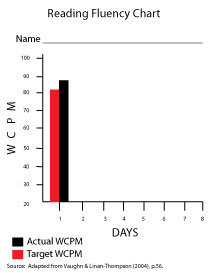Fluency is the ability to connect the words we read precisely and swiftly. Obtaining meaning from the text occurs when a child can quickly link words together into meaningful phrases; it is an essential element of both reading and comprehension. A child’s fluency can improve with the following exercises:
- Hearing a fluent reader read,
- Rereading the same text and
- Establishing a criteria.
Teachers typically establish benchmarks and monitor fluency progress for both speed and accuracy. Tracking the number of words a child can read correctly in a minute (WCPM) provides a great activity to monitor fluency. It is quite simply; all you need is two copies of a passage, a highlighter and a stop watch.
- Select an unfamiliar passage with an appropriate level of difficulty.
- Make two copies of the passage – one for the reader and one for the administrator.
- Give one copy to your child and use the second copy to mark errors.
- Instruct your child to begin reading when you give the signal.
- Using the stopwatch, time your child reading for one minute.
- While a child reads, track errors. Self correcting or repeating the text is not an error. However, treat any of the following as an error and exclude them from your final word count:
- Inability to read a word within 3 seconds,
- Incorrectly pronouncing a word and
- Omitting or adding a word.
- Stop counting after a minute and add the number of words read correctly.

After you obtain your child’s WCPM, compare it to the national norms. The tables below contain the national norms for second, third and fourth grade. National norms do not exist for kindergarten or first grade; fluency instruction typically begins in the later part of first grade or after a child develops strong word identification strategies. Above average represents reading norms in the 75th percentile, average represents reading norms in the 50th percentile and below average represents reading norms in the 25th percentile.
If your child is below average increase their fluency rate by performing more
modeling and rereading exercises . An average or above average child should continue to work on their fluency rate and increase the passage’s level of difficulty or benchmark. Make sure you praise your child when appropriate and provide encouragement while he is learning to read.
Reading Fluency Guidelines for Grade 2
| Rank | Fall WCPM | Winter WCPM | Spring WCPM |
| Above Average | 82 | 106 | 124 |
| Average | 53 | 78 | 94 |
| Below Average | 23 | 46 | 65 |
Source: Adapted from Vaugh & Linan-Thompson (2004), p.57.
Reading Fluency Guidelines for Grade 3
| Rank | Fall WCPM | Winter WCPM | Spring WCPM |
| Above Average | 107 | 123 | 142 |
| Average | 79 | 93 | 114 |
| Below Average | 65 | 70 | 87 |
Source: Adapted from Vaugh & Linan-Thompson (2004), p.57.
Reading Fluency Guidelines for Grade 4
| Rank | Fall WCPM | Winter WCPM | Spring WCPM |
| Above Average | 125 | 133 | 143 |
| Average | 99 | 112 | 118 |
| Below Average | 72 | 89 | 92 |
Source: Adapted from Vaugh & Linan-Thompson (2004), p.57.
Reference
Vaugh, S & Linan-Thompson, S (2004). Research-Based Methods of Reading Instruction. Alexandria, VA: ASCD.

Leave a Reply